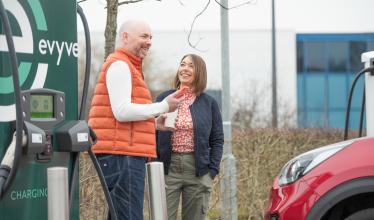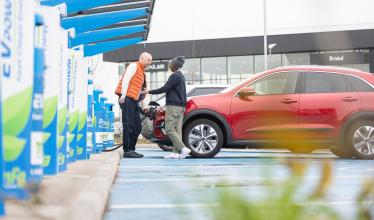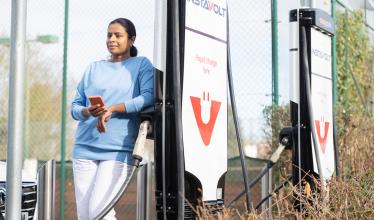Electric vehicles offer a number of benefits over conventional petrol or diesel models. Lower fuel costs, reduced maintenance bills, and zero or discounted car tax are just some of the ways that running costs are lowered, while environmental impacts are also significantly reduced.
The following sections explore the benefits offered by switching to an EV. For advice on purchasing a new electric vehicle, visit our EV buying guide.
Engaging drive

On trying an electric car for the first time, most drivers are immediately taken with the new driving experience. Although often promoted as being cheaper to run and a green vehicle choice, the majority of electric cars are also fun to drive and highly responsive. The torque available from an electric motor means that the initial acceleration offered by even standard EVs is more than offered by many sports cars.
The regenerative braking (which uses braking energy to charge the battery) offered by almost all electric vehicles means that you start ‘braking’ before your foot even touches the brake pedal. Add in the almost silent running and efficient aerodynamics, and EVs are usually both fun, comfortable and low stress to drive. Batteries are typically located low down in the car’s chassis, dropping the centre of gravity and allowing improved ride and handling characteristics.
While plug-in hybrid EVs have the added weight of combining a conventional with an electric powertrain, many PHEVs are as refined and engaging as a pure-EV, albeit with lower electric-only range. As well as being better suited for regular use on long journeys, they are usually more responsive at higher speeds due to the combination of engine and motor.
Practical plug-ins

Think how many trips you carry out that are less than 10 miles, or even less than 30 miles. Whether its the regular commute, completing the school run, or going to see family and friends, these journeys are comfortably within the range of all new pure-EVs and most plug-in hybrids.
EVs are ideally suited to driving in the city and other urban areas where traffic congestion and emissions are high. They are easier to drive, with lower stress on the driver, as well as being zero-emission at point of use. The high acceleration offered by most EVs makes them responsive on all types of road, with ‘regen’ braking reducing the amount of required pedal control.
For drivers with off-street parking, home charging is a practical solution. With an EV parked up overnight, charging can be completed off-peak for lower costs, and the car will be ready in the morning, fully charged and pre-conditioned to your required temperature. Workplace charging is also a practical solution to charging an EV when it’s parked up for several hours at a time.
Even for those without off-street parking, owning an EV is still a viable option, by using the public charging network or charging at work. New on-street options such as lamp-post charging are becoming more common across the UK and will ease pressure on local authorities to support residents with EVs but no dedicated parking bay.
Running costs

EVs reduce running costs compared to conventional cars. One reduction is in fuel costs. Despite increases in public charging prices over the last year, EV drivers are mostly still in a better position than drivers of petrol or diesel cars who have to fill up at the pumps.
For starters, many EV drivers charge at home for most of their energy needs – with the energy price cap currently sitting at around 34p/kWh – and might also have the option to install solar panels, or take advantage of a lower price off-peak tariff and so reduce the cost of charging their EV further.
Learn more about different charging scenarios in our monthly Price Index.
Evidence from fleets also shows that plug-in vehicles can reduce service, maintenance and repair costs by more than half when compared to petrol or diesel alternatives. This is due to the fact that pure-electric vehicles have fewer components that require maintenance, making servicing and any repairs simpler and cheaper than for conventional cars. Wear and tear on tyres and brakes is noticeably reduced on plug-in vehicles thanks to regenerative braking.
Insurance costs are broadly similar for electric cars compared to conventionally-powered models. While EVs tend to be in a higher insurance group than a comparable petrol or diesel car, the drivers themselves are often considered lower risk. There are a number of insurance firms – both general and specialists – available that will provide electric vehicle insurance for EV drivers.
For drivers in and around London, another major running cost benefit is available as part of the Congestion Charge scheme and Ultra Low Emission Zone (ULEZ). All electric cars (currently defined as vehicles that emit up to 75 g/km CO2, have a minimum electric range of 20 miles, and meet at least Euro 6 emissions standards) are eligible for the Cleaner Vehicle Discount, although vehicles need to be registered and pay an annual £10 fee.
As of 25th October 2021, the Ultra Low Emission Zone (ULEZ) in London has expanded to cover all areas within the North and South Circular – although the North Circular (A406) and South Circular (A205) roads are not in the ULEZ. The zone operates 24 hours a day, seven days a week, every day of the year (except Christmas Day) with the aim of helping to clean up the capital’s air. The minimum emission standards vehicles need to meet in order to drive inside ULEZ without incurring the £12.50 daily charge are Euro 4 standard for petrol and Euro 6 standard for diesel.
The London Congestion Charge zone operates 07:00-22:00 every day of the year, except Christmas Day and has a payable daily charge of £15. The maximum charge payable, for both zones, would therefore be £27.50. Taking advantage of the Cleaner Vehicle Discount could therefore provide a potential annual saving of over £10,000.
Zapmap has developed a range of online tools to calculate charging costs, including the Home Charging Calculator and Public Charging Calculator. The Journey Cost Calculator also allows drivers to compare the costs between a plug-in model and any other new car available in the UK.
Less-taxing tax

Fully electric vehicles are zero-rated for Vehicle Excise Duty (VED), removing a three-figure sum from annual car running costs. While PHEVs have to pay the same Standard Rate as petrol or diesel drivers, they are eligible for a £10 annual Alternative Fuel Discount. Note that the Premium Rate of £335 per annum for years two to five on top of the Standard Rate for models costing £40,000 or more applies to all models apart from pure-electric cars.
Company car BIK rates are also lowest for pure-EVs, with PHEVs also having lower rates than conventional vehicles. In the current financial year, battery-electric cars are BIK-rated at 2% until FY 24/25. Plug-in hybrids with CO2 emissions up to 50 g/km are BIK-rated at 2% to 14% depending on electric-only driving range, while those up to 75 g/km are rated between 15% and 20%.
Businesses operating EVs can also receive a tax break through the system of enhanced capital allowances (ECAs). From April 2021, the 100% Write Down Allowance (WDA) will extend first year allowances to pure-electric models only. Until then -the end of March 2021 – pure-EVs and PHEVs, together with the greenest ultra-low emission vehicles, are eligible for a 100% ‘write-down’ in the first-year of purchase. To qualify, the vehicle must be bought as new, have CO2 emissions of not more than 50 g/km (to March 2021) with the expenditure incurred before 31st March 2021. Recharging equipment is eligible under the ECA scheme.
Refined and high-tech

EVs are typically well equipped, sitting towards the top of a manufacturer’s trim levels. This helps improve the value-for-money offering for customers, lessening the impact of the higher initial purchase price over conventional models. Electric-specific features also mean there is plenty of on-board tech available for EV drivers.
Often standard EV features include regenerative braking, pre-conditioning, heated/cooled seats and steering wheel, charger timing, and remote access. These allow drivers to check on their car’s status from their phone or computer, set cabin temperatures to be ready for driving (good for convenience and efficiency) and give a premium feel to even the most compact city car. Settings are usually controlled via a manufacturer-provided app.
On-board refinement is aided by an EV’s quiet and smooth operation. While there is some noise and vibration from the electric motor, wind, and tyres, the levels are lower than with a conventional vehicle. The honed aerodynamics, designed to maximise EV range, also help to reduce noise levels, as does the use of low-rolling resistance tyres, again standard on most EV models. The effect is to further add to the refinement and spec of available EV models.
Ultra-low emissions

EVs are zero-emission at point of use. However, emissions are produced during the generation of electricity, the amount depending on the method of generation. Therefore, the emissions need to be considered on a life cycle basis so as to include power station emissions.
For climate change gases (such as CO2), electric cars charged using average UK electricity show a significant reduction in emissions; the figures suggest a reduction of around 25-40% compared to an average conventional car. Larger carbon reductions are likely in the future as the UK grid continues to ‘decarbonise’. If renewable or ‘green tariff’ electricity is used, then life cycle greenhouse gas emissions are effectively zero.
The reduction in carbon emissions is mainly due to the fact that electric cars are more energy efficient than conventional vehicles. This includes the ‘regen’ braking, which returns energy to the battery when the brakes are applied and improves fuel efficiency by around 20%.
For local air pollutants, including nitrogen oxides (NOx) and particulates (PMs), electric cars using average electricity are increased. However, as these are emitted from power-stations which are well away from urban areas, their overall impact tends to be much less than when emitted from the exhausts of petrol and diesel cars. As is the case with greenhouse gases, if renewable electricity is used, then life cycle regulated emissions are also virtually eliminated.
While the evidence is that EVs provide significant climate change benefits and reduce noise pollution, they may increase the potential impact on human health in areas where resources (such as lithium) are extracted for battery production. Indeed, the sourcing of lithium remains contentious relating to the level of reserves and the local impacts on human health where lithium ore is mined.
Taken overall, and given that current road transport is responsible for significant emissions of local air pollutants, the impact on human health of using EVs is certainly beneficial within urban areas, well away from the centres of battery production, due to the fact that most EVs are zero-emission at the point of use.



